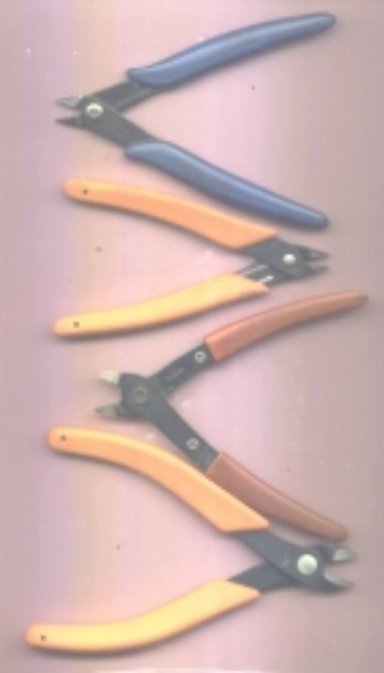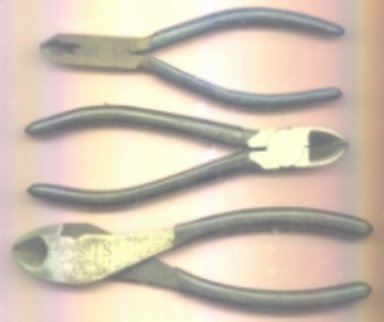Very frequently it s necessary to make quick cuts to size lengths of wire, nails, pins, mounting lugs, rail and small rods; or to free castings from runners by cutting gates. With two opposing, wedge chopping blades affixed to handles, nipping tools come in many variations and sizes. A major division separates the blades into two types. For more rugged cutting, the blade edges vee shaped wedges, which form vee shaped ends on both separate pieces. In many cases this presents no problem. Spring steel piano or music wire, commonly sold in hobby shops, will nick most standard cutters and virtually ruin blades. Although some specially hardened blades can cut it, an abrasive cut-off wheel is recommended.
Often called "flush cut", the other has one face of the edge aligned parallel with the direction of cut. This produces a straight end on the adjacent piece, while yielding a vee on the opposite piece. Raising no burrs, this creates an excellent rail cutter, however it is wise to slightly chamfer the top and inside corners of the railhead to eliminate possible flange picking on sharp edges. Inconveniently the opposite piece must be cut to remove the vee. Similar to surface shearing, this edge also permits flush trimming of items jutting from surfaces , for trimming handholds inside wall, gates on castings and wires on circuit boards.
Jaws on the vee type are usually bulkier, while flush cut tend to be slimmer. For position convenience, they may be straight out from handle or angled, even to perpendicular. Handles are usually plier type and proportioned to jaw size.
Flush slicing casting gates from plastic parts with a knife or razor blade can be treacherous. Some manufacturers, including Roundhouse and Bowser, seemed to have overlooked the fact that cutting tools must fit between runners and parts to cut gates, even to the extent that a #11 blade will not fit. if slightly angled for a flush cut. Chopping is too often impractical, due to projections on part or runner preventing proper backup at cut. One slip from applied force as cut is finished and something may be ruined.
Probably the most useful tools for freeing casting from runners are the Gyros pointed, flush cutting tweezer type with fine tip blades. In most cases gates can be nipped close enough to part to preclude any clean-up. Apparently these are hand ground, so blade may vary and selection through the blister pack is difficult. These should not be use on metal, unless nicks are desired. The blades can be sharpened with a small stone of very fine file. Tips can be reshaped by very careful grinding and minimum heating.

Note: Adjust brightness and contrast for optimum viewing.
GYROS FLUSH CUT TWEEZER NIPPERS

Note: Adjust brightness and contrast for optimum viewing.
BLADES
Each tool is reserved for a specific use. On the left one the arc behind the blades was ground to a thinner point to fit short gates. With its narrower tip, the middle one is used where lateral clearance is tight. While with its more parallel edges, the right one is used most, when sufficient clearance exists.
Occasionally some parts are connected directly to the pouring sprue without runners or have very heavy gates; this double leverage Merry flush cutter can exert a high force to cut most. Also it can handle softer non-ferrous metals.

Note: Adjust brightness and contrast for optimum viewing.
MERRY CUTTER
Originally designed for flush trimming component leads on circuit boards; with thin, flush cutting, blades, bent at an angle to the handles; these have found there way into the hobby field. They can cut mild steel. heavier gates when they fit and trim handhold legs on car wall backs.

Note: Adjust brightness and contrast for optimum viewing.
FLUSH ANGLE
In order of increasing thickness
Plato
Xuron
Taiwan
Xuron
Commonly called diagonal cutters or dikes, they are used commonly by electronics technicians or electricians and are almost a standard for general, heavier cutting. Most can cut mild steel wire, but not spring music wire. A fine manicurist's type can sometimes fit tight, small gate situations, where others can not. As an expedient, many pliers have cutters built-in, however those found on the common gas pump pliers and those referred to as side cutters are usually shear type cutters.

Note: Adjust brightness and contrast for optimum viewing.
SMALL DIAGONAL CUTTERS
Manicure flush
Dixon fine flush
Xacto crude vee
Long nose w/ cutter
Larger sizes are useful in cases beyond the capabilities of the modelling sizes. Many exist with handles longer than 36" for cutting bolts, lock hasps and heavy rod. One type, with sharp, flush cutting blades, cuts rail very cleanly with practically no burrs and is often sold as rail nippers. Beware these nick very easily, even with harder brass.

Note: Adjust brightness and contrast for optimum viewing.
LARGE DIAGONAL CUTTERS
Dixon rail nippers flush
Dikes flush
Heavy vee cut
Frequently none of the above types will fit due to handle clearance requirements. With edges perpendicular to handle line, end cutters can cut along surfaces at the bottom of holes, large enough for access.

Note: Adjust brightness and contrast for optimum viewing.
END CUTTERS
Small Lindstrom jeweler's flush
Sears flush
Pittsburg vee
All of the edges will eventually dull, reducing their cutting ability. They may also get nicked inadvertently. With care edges can be restored with PROPER SHARPENING .
BACK TO CUTTING
BACK TO TOOLS INDEX
